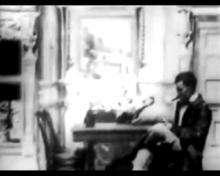Substitution splice


The substitution splice[1][2] is a cinematic special effect in which film makers achieve an appearance, disappearance, or transformation using a cut.[1] It is sometimes also called the stop trick[3] or the stop motion substitution, although the effect is achieved through film editing rather than by literally stopping the camera.[2]
The pioneering French filmmaker Georges Méliès claimed to have accidentally developed substitution splicing while filming street traffic at the Place de l'Opéra in Paris. According to his story, his camera jammed and stopped; by the time he had solved the difficulty, the traffic had moved on. When the film was screened, a man appeared to change into a woman, and an omnibus seemed to turn into a hearse. No evidence has emerged to support this story, which was probably entirely invented by Méliès.[2] According to the film scholar Jacques Deslandes, it is more likely that Méliès discovered the substitution splice by carefully examining a print of the Edison Manufacturing Company's 1895 film The Execution of Mary Queen of Scots, in which a primitive version of the trick appears. In any case, the substitution splice was both the first special effect Méliès perfected, and the most important in his body of work.[2]
For some time, film theorists mistakenly believed that the camera was actually stopped for the effect, and then restarted (hence the occasionally used term "stop trick"). However, later film historians such as Richard Abel and Elizabeth Ezra established that the effect was the result of Méliès's careful frame matching during the editing process, creating a seamless match cut out of two separately staged shots.[4] Indeed, Méliès often used substitution splicing not as an obvious special effect, but as an inconspicuous editing technique, matching and combining short takes into one apparently seamless longer shot.[5] Substitution splicing could become even more seamless when the film was colored by hand, as many of Méliès's films were; the addition of painted color acts as a sleight of hand technique allowing the cuts to pass by unnoticed.[6]
The substitution splice was the most popular cinematic special effect in early film fantasies, especially those that evolved from the stage tradition of the féerie.[1] Segundo de Chomón is among the other filmmakers who used substitution splicing to create elaborate fantasy effects.[1] D.W. Griffith's 1909 film The Curtain Pole, starring Mack Sennett, used substitution splices for comedic effect.[7] The transformations made possible by the substitution splice were so central to early fantasy films that, in France, such films were often described simply as scènes à transformation.[8]
This technique is different from the stop motion technique, in which the entire shot is created frame by frame.
References
- 1 2 3 4 Moen, Kristian (2012), Film and Fairy Tales: The Birth of Modern Fantasy, London: I.B. Tauris & Co, p. 41
- 1 2 3 4 Williams, Alan Larson (1992), Republic of Images: A History of French Filmmaking, Cambridge, MA: Harvard University Press, p. 36
- ↑ Weinstock, Jeffrey Andrew (2012), The Vampire Film: Undead Cinema, London: Wallflower, p. 76
- ↑ Lim, Bliss Cua (2009), Translating Time: Cinema, the Fantastic, and Temporal Critique, Durham: Duke University Press, pp. 279–80
- ↑ Solomon, Matthew (2011), "Introduction", in Solomon, Matthew, Fantastic Voyages of the Cinematic Imagination: Georges Méliès's Trip to the Moon, Albany: State University of New York Press, pp. 6–7
- ↑ Yumibe, Joshua (2012), Moving Color: Early Film, Mass Culture, Modernism, New Brunswick, NJ: Rutgers University Press, pp. 71–2
- ↑ Gunning, Tom (1991), D.W. Griffith and the Origins of American Narrative Film: The Early Years at Biograph, Urbana: University of Illinois Press, p. 132
- ↑ Kessler, Frank (2005), "Trick films", in Abel, Richard, Encyclopedia of Early Cinema, Abingdon: Routledge, p. 644